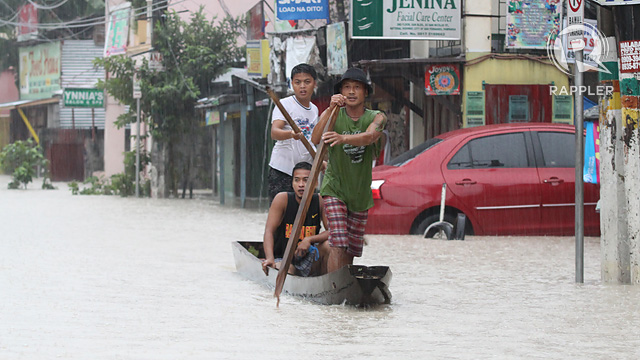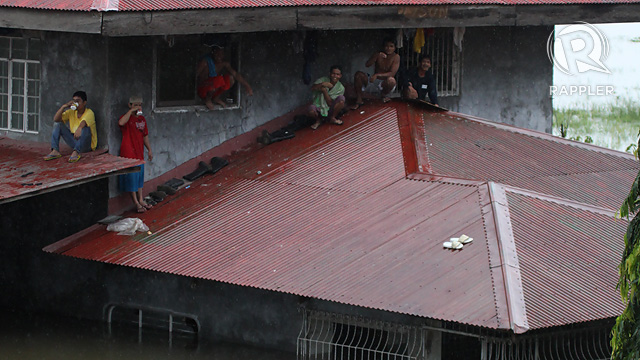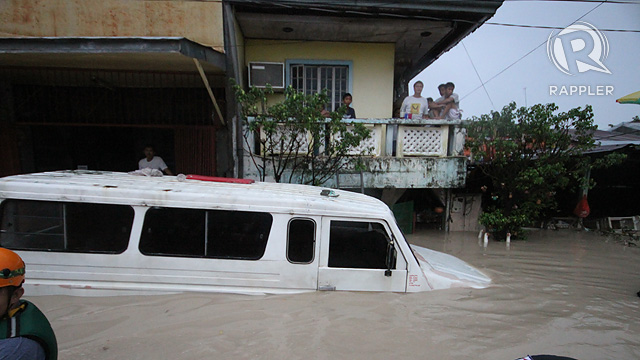SUMMARY
This is AI generated summarization, which may have errors. For context, always refer to the full article.
MANILA, Philippines – This time, the disaster had no name.
But I’ll remember it. Always.
It was my first flood coverage.
Rains had calmed somewhat in Manila two days after the first monsoon rains hit the city. But in Santo Tomas, Pampanga, the devastation was extreme.
Pampanga was silent.
As I rode the back of a truck through the province with my crew and a rescue team, what struck me most was the nothingness.
There was, eerily, little sign of life.
The only sounds were of the pouring rain and the splash of the water against the truck’s wheels, as we drove through the barely visible streets, buried by water stretching for miles and miles.
It was like cruising through a murky ocean.
Occasionally we passed houses on the side, their roofs peeping from the brown water; half-submerged trees, and rice fields completely blanketed by floods.
It was 4 pm by the time we arrived at Santo Tomas.
There, a river of floodwaters had torn right through the town. Mayor Jerry Pelayo of Candaba said the water had killed 6.
Part of the tail dike in neighboring Bacolor, he said, had exploded, and the rush of floodwater caught residents off guard, flowing through streets, creeping into rooms, and rising, higher and higher, filling the first floor of most houses.
The skies were dark. Residents had gathered in the town’s center, carrying belongings, standing helplessly, finding food. Their faces were of confusion, peppered with unanswered questions, waiting. No one really knew what to do.
With our sole rubber boat, we ventured deeper into the town to search for stranded residents.
Nothingness
Photos can only do so much. I had grown up watching this same typhoon-ravaged scene on television, ogling at snapshots plastered on newspapers. We live in the Philippines after all.
But there is nothing like actually being there, in the center of it, feeling the sense of helplessness hanging in the air, and experiencing the difficulty of a town completely halted by rain.
There were no open stores, no passable roads, no electricity — nothing.
When I wasn’t on the boat, I found myself wading through brown waist-deep waters, dead roaches floating around me.
Most houses were empty. A few residents peeked out of their second floor balconies, sat on elevated doorsteps, while others looked on from the top of abandoned jeepneys.
Some yelled from their spots at us, telling us they didn’t need rescue, they needed food.
I wondered why they preferred to stay.
We went deeper and deeper into the town — at this point having traveled over 4 hours from Manila — only to find out that rescue teams from nearby Tarlac had already saved the most endangered victims.
Night caught up with us fast, and darkness fell.
We were forced to turn back around, back to the town’s center. The whole town of Santo Tomas had no power, and except for lights in the distance from a television network’s live shot, the town was pitch black.
I imagined what it would be like once the TV lights packed up and went.
For those who chose to stay in, what was left of their home, how, I wondered, did it feel to sleep in utter darkness, cold, wet and hungry, in fear of the water reaching you overnight? How did it feel to not know when the rain would stop pouring and when you could eat again? And when daylight broke, how did it feel to sit there for hours, just waiting?
It wasn’t, in the words of NDRRMC Undersecretary Benito Ramos, just “Waterworld.”
It was hell.
Lessons from the rain
I think when rain falls, this is what we need to remember: the situation is always worse than what the photos and the video can possibly show us.
And while residents may be used to flooding in their areas, it comes alongside suffering, misery and starvation, and these are human intricacies one can never, and should never, get used to.
The situation is always urgent.
It is also always more complicated than it seems.
I later learned some residents chose not to leave their submerged homes because in actuality, there was nowhere to go.
The singular church turned makeshift evacuation center of Santo Tomas was not only full to the brim, but short on food, water and basic necessities.
Towns like Santo Tomas that are difficult to reach make them all the more challenging to supply and to feed.
And this makes underutilized rescue efforts a huge waste.
The rescue team I came with, led by Coast Guard Ted Esguerra, had spent the day before saving 79 lives in Marikina. Their trip to Pampanga the next day could have been more useful had communication been better.
The team could have brought food had they known it was relief the town needed, and not rescue. Or perhaps they could have been deployed elsewhere altogether, to areas that still needed rescue, while another team could have delivered food to Santo Tomas.
Seemingly simple problems that could have far-reaching consequences.
Improved organization of rescue efforts, a centralized rescue system: this is what the country needs. A single hotline — our own version of 911, says Esguerra — that would undoubtedly save more lives.
Yet as complicated as it may seem and as many problems there are still left to be addressed, it is, at the core of it, quite simple.
There’s a moment from my coverage I remember vividly, days after the rains have gone and the roads have dried.
Through the rainfall, a voice.
As we floated through Santo Tomas, one man who sat by his window, surrounded by nothing but water, watched us pass.
And instantly, upon seeing us, a huge group of 10, he yelled out loud and clear through the downpour: Kain po kayo!
He had little to offer.
This, at the end of the day, may be the most important lesson I take away from my first disaster coverage, and one I wish that I, or the government, will never forget.
That in the deepest of darkness, in every disaster, nameless or not, there are faces, many of them.
Faces with emotions, a capacity for love and kindness, and a heart worth saving. – Rappler.com, photos by Josh Albelda
Add a comment
How does this make you feel?







There are no comments yet. Add your comment to start the conversation.